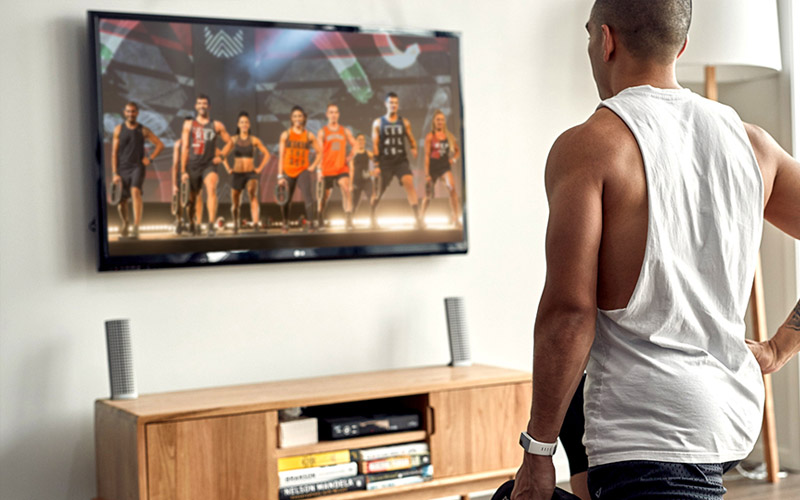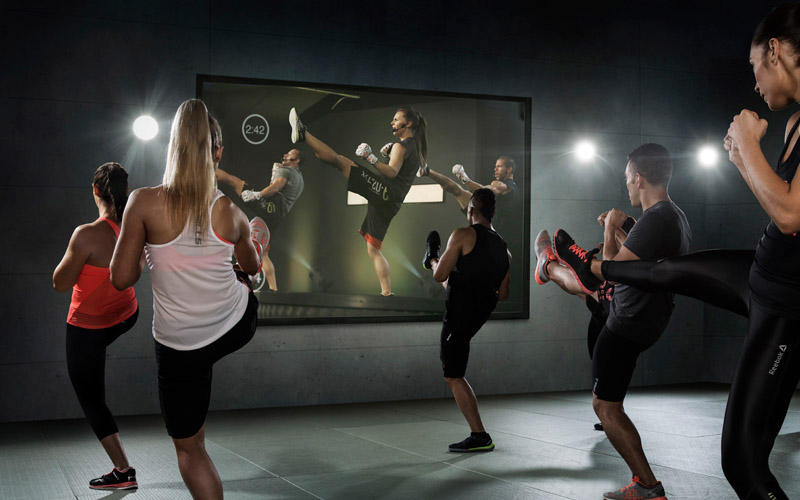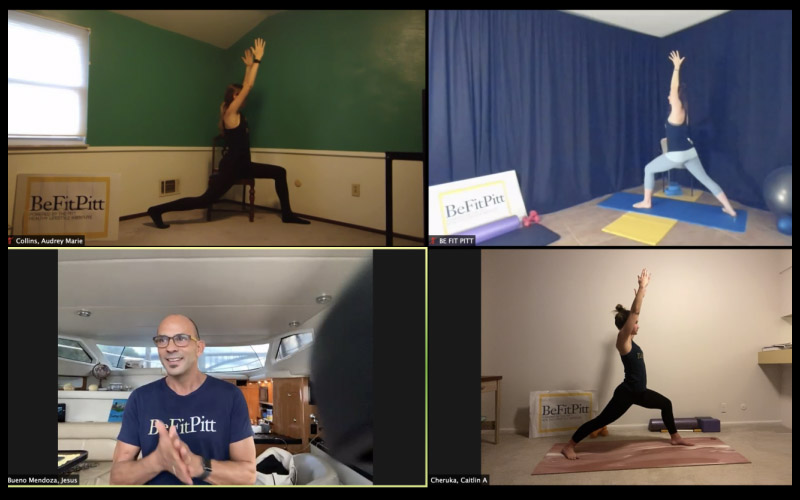Like a lot of gym owners, Shelley Turk had thought about offering virtual fitness services someday.
Four years ago, she thought of “someday” as in far off into the future, with plenty of time to plan and organize.
But then life happened super-fast in early 2020, when the Covid-19 pandemic forced everyone to change tactics quickly.

For Shelley and others in fitness, that meant introducing virtual fitness services almost overnight, installing equipment, learning what the heck this “Zoom” thing was, and training members to get up and running.
“It took us 36 hours,” says Shelley, owner of ProActive Fitness in Saskatoon, Saskatchewan, in Canada.
Four years later, virtual fitness services remain a fixture at ProActive, long after the pandemic.
Like a lot of gym and studio owners, Shelley learned that there were many excellent, enduring reasons to offer virtual fitness services that had nothing to do with the crisis of the pandemic.
While some gym owners have dropped virtual training, many continue to offer it in some form. Individual personal trainers have also been developing their own apps to sell programming, videos, support, and access.
If before the pandemic, this all seemed “someday,” now it seems “business as usual” for many.
So, if you’re wondering if you should include virtual fitness services, here are some things to consider.

First, it’s up to you.
· You know your community and customer base better than anybody. What works for them, and what doesn’t?
· Is it necessary for your current business goals?
· Does it feel like a smart thing to do just in case something terrible happens again?
All up to you.
But those who believe in offering virtual fitness solutions, like Shelley, point out some strong positive aspects about it.
“Once we got the technology set up for it, it didn’t make sense to ever stop offering it. We offer both group fitness and personal training in person and online,” says Mark Nutting, owner of Jiva Fitness in Easton, Pennsylvania.
“As for how it’s going… most of the people that switched to virtual have continued on virtual.”
With the rise of virtual fitness services, gym owners have an unprecedented opportunity to engage clients beyond the confines of their physical space, taking on new clients from anywhere and staying in touch with clients who travel or can’t make it into the facility.
Virtual fitness isn’t just a trend induced by a disaster; it’s going to remain a powerful tool for building a thriving business and reaching a broader audience.
You don’t have to go all in. But consider if you shouldn’t at least be capable of virtual training, selling videos of your programming, or introducing an app for your gym or studio. Remember, a “strange new world” came true not long ago, and it’s best to remain prepared.
Benefits of Virtual Fitness Services
First, by training people virtually, through Zoom or some other “live” connection, you can train more people at a time. Shelley, for instance, has Zoom sessions with up to 10 people, which is more than her in-person per-class limit.
“It’s more income,” Shelley says. “I can serve more people.”

It offers staff flexibility. Shelley’s virtual trainers are remote employees, so she can hire from outside her town. And this leaves her in-studio staff members free to focus on the members who are with them in person.
And when a member must cancel at the last minute, there’s the option of making up the session remotely.
That brings up another key point: You don’t have to choose virtual or “in person.” In fact, “hybrid” training emerged from the pandemic as a bright path forward for many.
That can mean a range of things, but essentially it keeps your options open for your business and your members.
And that leads to another advantage of having virtual fitness services: Members can stay members even when they can’t come into the studio. Some of Shelley’s members are farmers who live outside of town, and there are times of the year when it’s difficult for them to come in.
Further, she lives where it’s very cold for much of the winter, so there’s some drop-off in attendance.
And a significant number of members spend at least part of the winter in warmer locations.
But they remain active members via Zoom workouts. It’s good for Shelley’s membership figures and it keeps the individual members from getting out of shape, then having to work hard to get back to a baseline each spring.
Individual Trainers Have Options, Too
For individual trainers who lack their own brick-and-mortar facility, virtual fitness services can be the base of their business, or an addition to work they do at someone else’s gym.
Like others, independent trainer Myrie Jackson of Atlanta is launching his own app, where paying members have access to his training programs, including videos and more.
He also trains individuals at a local gym.
“My own app enables me to train people from anywhere in the world, so I’m not tied down to just how many individuals I can see each day at the gym,” he says.
“It’s letting me create my own training system and market it to more people I can help, and I don’t have to be there in person since they have me on the app.”

Holly Benson of Lakewood, Colorado, says virtual fitness services “open up opportunities for the gym-averse and those with limited time or transportation challenges.”
A Little Advice
If you’re thinking about going virtual, invest a little time and planning.
It’s important to pick reliable equipment and have a strong Internet connection. From streaming workouts to interactive coaching platforms, there’s a wealth of tools available to gym owners. Invest in user-friendly software that offers seamless streaming, interactive features, and robust communication tools.
Have a dedicated space, with good lighting.
It doesn’t have to look like a TV studio, but you can’t wing it like in the early days of the pandemic, when everyone had a “we’re all in this together” spirit.
Use technology to individualize member experience and track data, like attendance and feedback.
In addition to “live” training sessions, you can create content to captivate, educate and inspire an audience and keep them coming back for more.
You can build a video library of workouts focusing on strength training, cardio, flexibility – even other topics like mindfulness and nutrition. You can sell self-published books, eBooks, and printed workouts.
Virtual fitness services can lead to secondary income streams if you are providing further goods and services. (Read this article for further tips on how to bring in extra revenue.)
Build Community
Virtual “town halls” are great ways to foster community and share information with all your members at once – about new services, plans you’re considering, upcoming special events and more.
Bring in an outside expert to dive deep on something your members care about or offer a cooking class. With virtual capabilities, you can “bring in” anyone from anywhere, at any time.
Shelley, who is a Naamly partner, uses our texting to make sure she virtually “touches” each member at least once a month with a positive comment about how they’re doing. The Naamly dashboard lets her see instantly which members haven’t been contacted lately.

Virtual fitness services can provide feedback to use in adjusting programming, customizing workouts, and boosting accountability.
It’s another tool in building the all-important community around members – even those who don’t come in regularly.
Here are some ideas to make sure virtual members feel “a part of things.”
· Have periodic parties or summer BBQs and invite everyone.
· Invite virtual members into the studio at least twice a year for a one-on-one “check-in” with a trainer.
· Make sure they’re invited at coffeeshop outings and other social events.
· Go on group outings to hiking trails, ballclubs, and other fun events.
· Acknowledge their milestones, like 100th workouts and birthdays, in newsletters and social media, just like you do for others.
These are all good tactics to build community in general and serve a double purpose with virtual members who can participate.
For Shelley, offering virtual fitness services became an instant lifeline. Now, they’re just another part of her robust, thriving business.
She understands that it might not be what everyone wants to do for their own gyms or studios. But, as the new competitive landscape reveals, the world changed four years ago, and it’s not going all the way back.
“There are so many gyms and studios who are doing it well,” she says.
So, at least, stay informed, openminded and prepared. The gyms and studios that did best during the pandemic were nimble enough to embrace virtual fitness services, at least temporarily. You will be able to cope best next time disaster strikes if you also stay on your toes, eyes open.

To learn more about how you can do it well and keep current members engaged and happy, check out our “9 Secrets to Increase Retention.”

